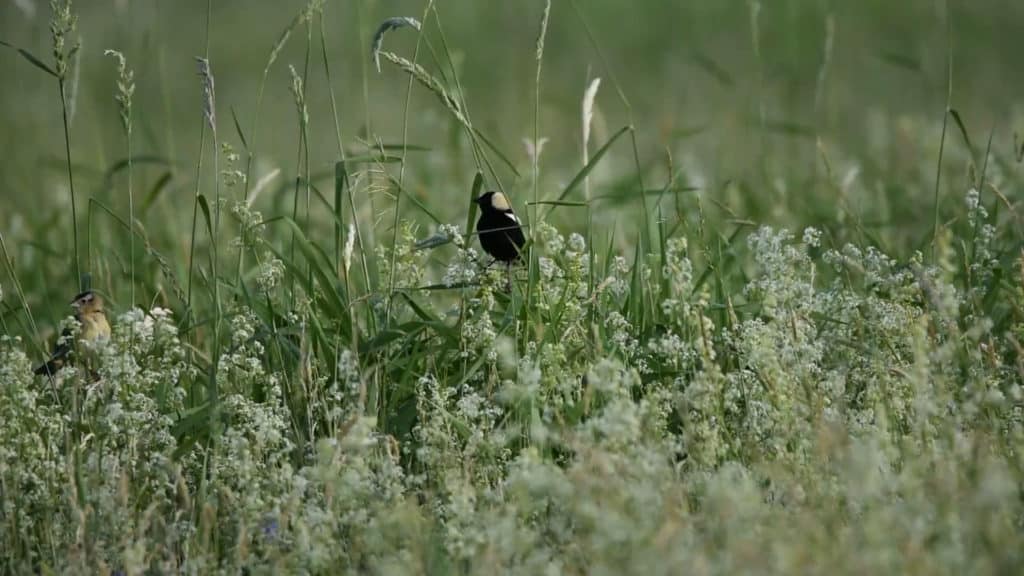
Maine Audubon is working with experts and activists to find avenues to pesticide policy reform.
Neonicotinoids, or neonics for short, are some of the most widely used and promoted pesticides on the planet. They kill insects, all of them, and are sprayed from planes, coated on seeds, and otherwise broadcast throughout virtually every cultivated (i.e., development, agriculture, silviculture, golf courses, botanical gardens, etc.) landscape. While neonics have been around for decades, we are still learning about their impacts on wildlife and habitat.
Thanks to our friend Scott Weidensaul and others, Maine Audubon is exploring what we can do to help. Scott is a renowned ornithologist and Pulitzer Prize finalist author, and over the summer he researched and wrote an article for Cornell’s “Living Bird” magazine called “Neonic Nation: Is Widespread Pesticide Use Connected To Grassland Bird Declines?” We asked Scott to help us with developing public programming around this work and topic.
Scott graciously obliged us, and on November 17, he joined forces with another good friend of Maine Audubon, Barbara Vickery, and Maine Audubon’s Conservation Director Sally Stockwell to help shed more light on the problem, and especially the opportunities, here in Maine. As a concerned private citizen, Barbara has spent hours combing through public records related to the application of neonics in Maine.
Between Scott’s extensive research at the federal and international level, and Barbara’s focused effort at the State House, there is too much to try to recap here, but some key takeaways from the November talk include these facts:
- Neonicotinoids are widespread, even in places where they are not used directly. Neonics last a long time, dissolve/travel in water, and show up far from their point source. This makes them a systemic problem similar to microplastics, PFAS, and, in the old days, DDT. In some cases, an individual or entity might pledge to not use them or use them only sparingly as a last resort. However, in many cases, neonics are used prophylactically, or applied whether there are pests or not.
- Due to a loophole referred to as the “Treated Article Exemption,” neonicotinoid-soaked seeds are exempt from most reporting requirements. The trouble with this is twofold. First, the seed will germinate and grow into a living organism, hardly a static “article,” which will then be toxic if consumed by any insect. Still worse, the vast majority (between 80-98%!) of the seed “treatment” will wash off the seed and into the soil and surrounding ecosystem, watershed, etc.
- Although there isn’t the clear scientific “smoking gun” linking neonics directly to global bird declines, there is plenty of damning evidence of impacts throughout ecosystems and food webs. We are also still learning the effects of bioaccumulation, when repeated treatments persist and build up within the soil, water, and organisms nearby.
- In Maine, the State Board of Pesticides maintains paper records (that’s right, they aren’t digitized!) of applications to spray pesticides like neonics. In her hours of review, Barbara was struck particularly by how many applications came from large blueberry farms, where the genus Vaccinium is the larval host plant for nearly 300 species of native butterflies and moths, and golf courses.
While the problems with neonics (and other pesticides) are enormous and intractable, there are still actions we can and should take. We can learn about and curtail our own use of systemic pesticides and especially insecticides (hint: that flea/tick spray, powder, or treatment for your pet might be or contain a neonicotinoid; check the ingredients). We can act “with our pocketbooks” by demanding to know the source of our plants and produce, and only buy from farms and nurseries that pledge not to use neonics. We can be advocates and ambassadors within our own home associations and communities by demanding alternative and neonic-free pest management regimes.
Perhaps most importantly, you can sign up for Maine Audubon Action Alerts and continue to follow our programs and policy efforts around this important issue. Most timely and pressing, the U.S. Environmental Protection Agency is in the process of a once-a-decade review of neonicotinoids, with an opening for public comment expected in Spring 2023. Please stay tuned for more Maine Audubon education and leadership on this issue…
